

 The Edge of th Empire, core rulebook and first part of the RPG trilogy that Fantasy Flight Games intends to release over the coming years. Edge of the Empire takes place around the time following the destruction of the first Death Star. So this is a original trilogy universe with no connections to the horrible prequels. The theme for the core rulebook is centered around the fringes of society, with outlaws, smugglers and all sorts of shady characters making their living at the edges of the Empire in the outer rim territories. The ongoing rebellion is going on in the background but should not be the primary concern of the adventures. Neither does the game feature the Jedi order or the Sith lords, though there is an option for "force sensitive" characters which I will talk about later. In essence this game allows you to play Han Solo type characters and exploring the Star Wars universe from a less heroic viewpoint which in itself should serve to create (imo) a lot more interesting adventures and stories.
The Edge of th Empire, core rulebook and first part of the RPG trilogy that Fantasy Flight Games intends to release over the coming years. Edge of the Empire takes place around the time following the destruction of the first Death Star. So this is a original trilogy universe with no connections to the horrible prequels. The theme for the core rulebook is centered around the fringes of society, with outlaws, smugglers and all sorts of shady characters making their living at the edges of the Empire in the outer rim territories. The ongoing rebellion is going on in the background but should not be the primary concern of the adventures. Neither does the game feature the Jedi order or the Sith lords, though there is an option for "force sensitive" characters which I will talk about later. In essence this game allows you to play Han Solo type characters and exploring the Star Wars universe from a less heroic viewpoint which in itself should serve to create (imo) a lot more interesting adventures and stories.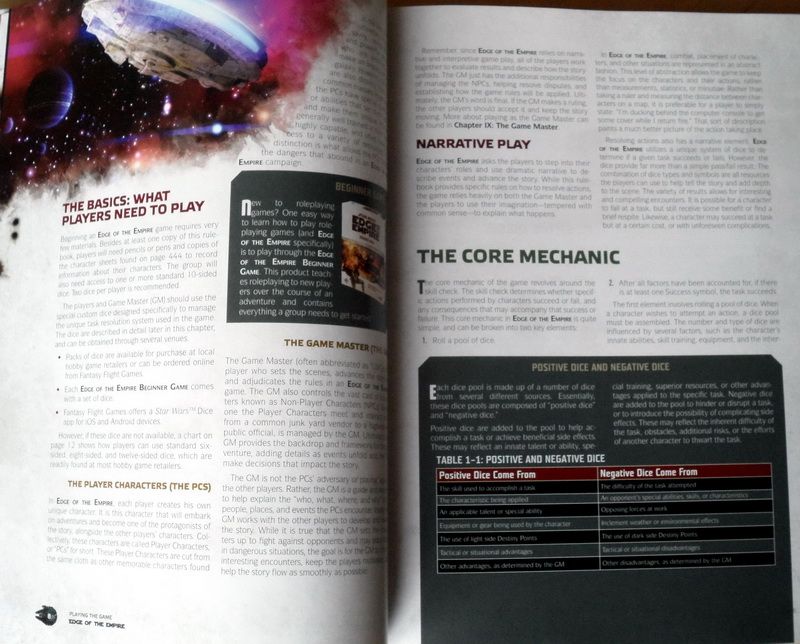 The book itself is of amazing quality, money well spent if you hesitate about the price tag. The binding is superb, the quality of the print and the paper is also top notch and it's hardback. The book includes over 440 pages and has thirteen chapters of which twelve chapters are of rules and information needed to play games and one being a complete adventure for players to play.
The book itself is of amazing quality, money well spent if you hesitate about the price tag. The binding is superb, the quality of the print and the paper is also top notch and it's hardback. The book includes over 440 pages and has thirteen chapters of which twelve chapters are of rules and information needed to play games and one being a complete adventure for players to play.1: Playing the game
2: Character creation
3: Skills
4: Talents
5: Gear and Equipment
6: Conflict and combat
7: Starships and vehicles
8: The Force
9: The game master
10: The galaxy
11: Law and society
12: Adversaries
13: Trouble brewing (complete adventure)
Narrative dice
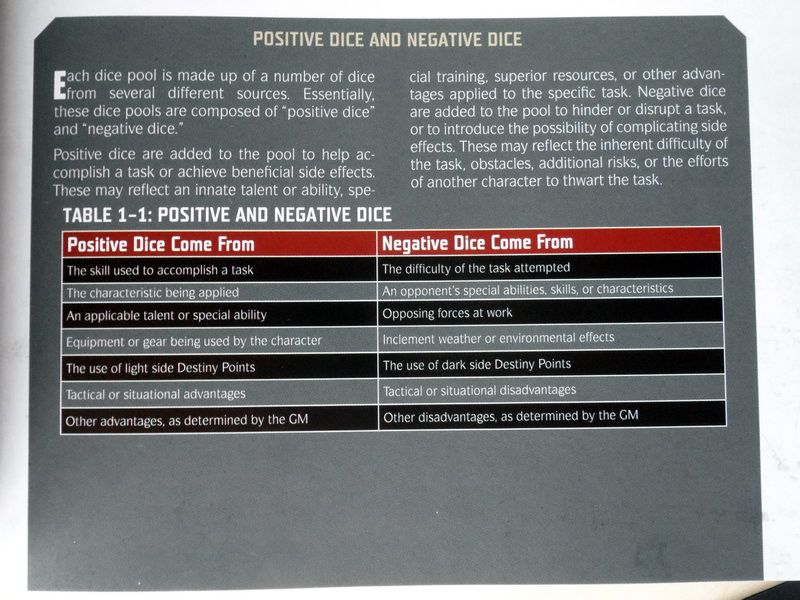

 The first thing the game explains is how you use the narrative dice, since Edge of the Empire only uses percentile dice to generate a few things during character creation and when rolling critical hits on ships and characters. Everything else in the game uses the narrative dice which are made up of 3 positive, 3 negative and one Neutral die.
The first thing the game explains is how you use the narrative dice, since Edge of the Empire only uses percentile dice to generate a few things during character creation and when rolling critical hits on ships and characters. Everything else in the game uses the narrative dice which are made up of 3 positive, 3 negative and one Neutral die.The dice mechanic may not be everyone’s cup of tea, I however really like it and don't find it cumbersome or fiddly. It uses custom D6/8/12 dice with various symbols, positive and negative. The ground total of uncancelled results is the result of your skill check. To pass or fail you need only to score a single excess result. However the game also
 uses something called "Threat" and "Advantage", which is represented with other symbols on the dice. In short, this means that you can succeed at something but suffer "threat", which can be translated by the GM according to a fixed chart depending on the situation (combat, space combat) or interpreted according to the story element - perhaps you were trying to strike a deal with a merchant. You roll a success and get to buy the item you are looking for, but the uncancelled threat symbols increase the price of the item above the original price.
uses something called "Threat" and "Advantage", which is represented with other symbols on the dice. In short, this means that you can succeed at something but suffer "threat", which can be translated by the GM according to a fixed chart depending on the situation (combat, space combat) or interpreted according to the story element - perhaps you were trying to strike a deal with a merchant. You roll a success and get to buy the item you are looking for, but the uncancelled threat symbols increase the price of the item above the original price. The narrative dice are really a great tool for players who like to weave storytelling into skill checks and allows for a great deal of improvisation during any session. A player can ask the GM if he might have heard ot the criminal he is chasing, the GM allows the player to roll a "Knowledge Underworld" check. The player passes this roll, meaning he knows the criminal and can better prepare himself, then depending on whether he rolls a threat or advantage result the GM can apply further modifiers - perhaps the player becomes scared because of the reputation of the criminal. The possibilities are really only limited by player and GM imagination. This type of gaming also requires a specific mindset and can take some time getting used to, and the game really benefits from both having the GM and the players help each other out interpreting such results to keep the story going.
The narrative dice are really a great tool for players who like to weave storytelling into skill checks and allows for a great deal of improvisation during any session. A player can ask the GM if he might have heard ot the criminal he is chasing, the GM allows the player to roll a "Knowledge Underworld" check. The player passes this roll, meaning he knows the criminal and can better prepare himself, then depending on whether he rolls a threat or advantage result the GM can apply further modifiers - perhaps the player becomes scared because of the reputation of the criminal. The possibilities are really only limited by player and GM imagination. This type of gaming also requires a specific mindset and can take some time getting used to, and the game really benefits from both having the GM and the players help each other out interpreting such results to keep the story going.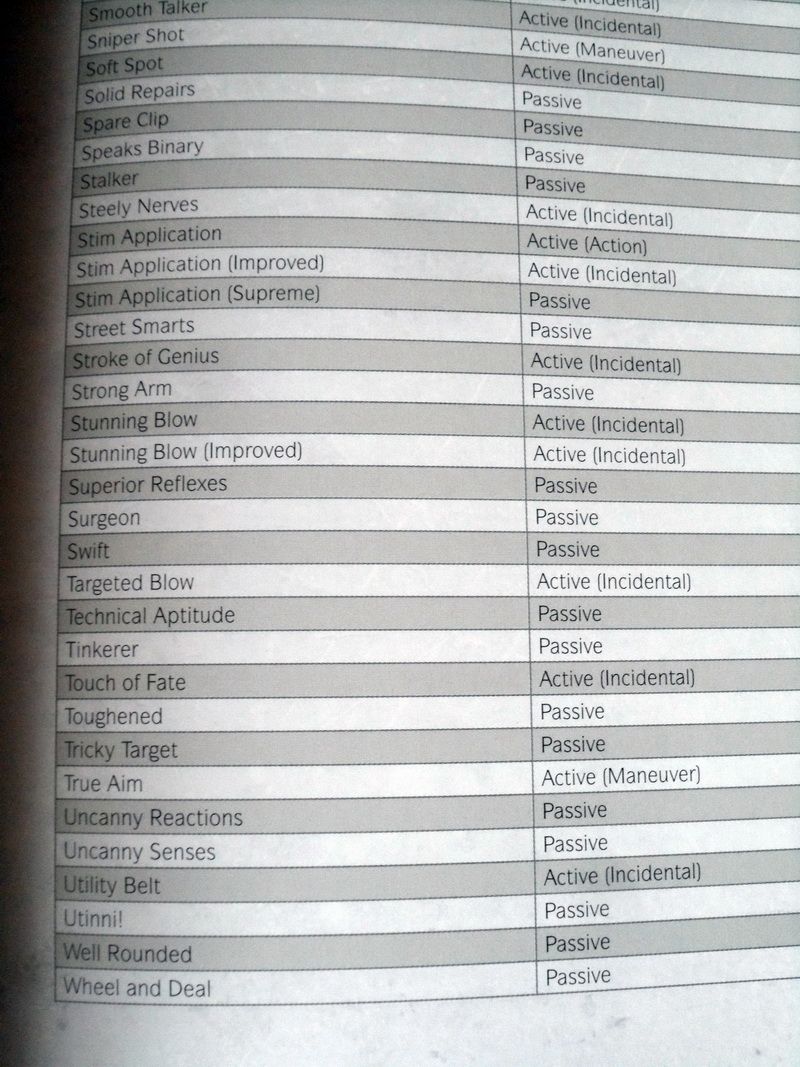 As for basic skill checks the game combines both player characteristics, which are the basic stats and skill points which players invests their XP into. The guiding principle here is that you compare both of these attributes, pick the one that is higher and use it as your "base" of "ability dice". Then you take the attribute that is lower and use it to upgrade your base pool with "proficiency" dice. This makes it fairly easy to quickly assemble and determine which dice to use, and how many.
As for basic skill checks the game combines both player characteristics, which are the basic stats and skill points which players invests their XP into. The guiding principle here is that you compare both of these attributes, pick the one that is higher and use it as your "base" of "ability dice". Then you take the attribute that is lower and use it to upgrade your base pool with "proficiency" dice. This makes it fairly easy to quickly assemble and determine which dice to use, and how many.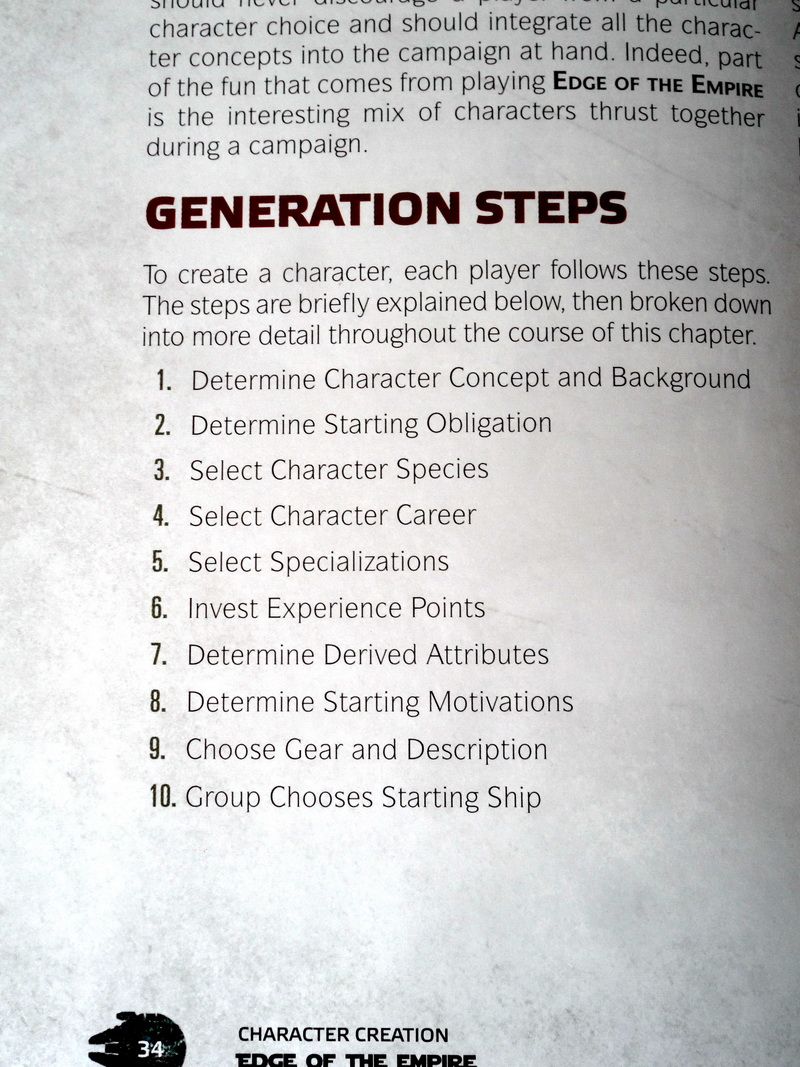 Having a characteristic of "Agility: 2", and the skill of "Ranged Light: 0" when attempting to fire at an enemy would simply mean that you only have 2 green ability dice. If your "Ranged Light" skill would be 1, then one of your green ability dice would be upgraded to a yellow proficiency die. Two other dice are used when making skill checks, light blue boost dice and black setback dice. These feature the same symbols as the other negative or positive dice, and their addition can make for a slight increase or decrease of your chances to do something.
Having a characteristic of "Agility: 2", and the skill of "Ranged Light: 0" when attempting to fire at an enemy would simply mean that you only have 2 green ability dice. If your "Ranged Light" skill would be 1, then one of your green ability dice would be upgraded to a yellow proficiency die. Two other dice are used when making skill checks, light blue boost dice and black setback dice. These feature the same symbols as the other negative or positive dice, and their addition can make for a slight increase or decrease of your chances to do something.Character creation, motivation and obligation
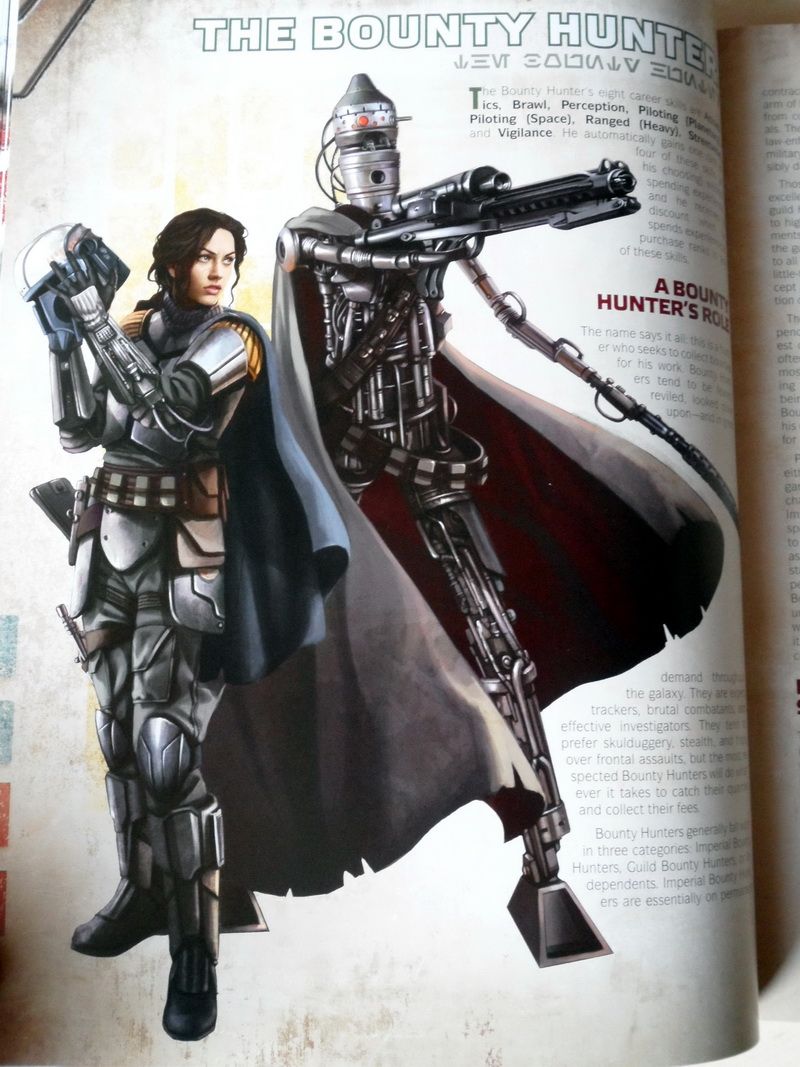 The character creation step in the core rules allows players to pick from 8 races (Human, Wookie, Droid, Trandoshian, Twi´lek, Bothan, Gand and Rodian) - but already players can pick from a lot of additional races which have been written with stats for EotE with the help of this unofficial release: https://docs.google.com/file/d/0B-bx0pVzywUJWXdodDA2M0pnQk0/edit?pli=1
The character creation step in the core rules allows players to pick from 8 races (Human, Wookie, Droid, Trandoshian, Twi´lek, Bothan, Gand and Rodian) - but already players can pick from a lot of additional races which have been written with stats for EotE with the help of this unofficial release: https://docs.google.com/file/d/0B-bx0pVzywUJWXdodDA2M0pnQk0/edit?pli=1 Having picked a race you pick a "career", this essentially gives you a character archetype. The careers that you can choose from are Bounty Hunter, Colonist, Explorer, Hired Gun, Smuggler and Technician. Each career has the player choose from one of three specializations which further dictate what your favored skills will be. For instance the Smuggler career can pick from Pilot, Scoundrel and Thief - each of these belong to the same career but provides different paths and different character builds. Each specialization comes with its own talent tree which allows players to customize and tailor their characters even further.
Having picked a race you pick a "career", this essentially gives you a character archetype. The careers that you can choose from are Bounty Hunter, Colonist, Explorer, Hired Gun, Smuggler and Technician. Each career has the player choose from one of three specializations which further dictate what your favored skills will be. For instance the Smuggler career can pick from Pilot, Scoundrel and Thief - each of these belong to the same career but provides different paths and different character builds. Each specialization comes with its own talent tree which allows players to customize and tailor their characters even further.The nice thing about this game is that it allows you to branch out and have several specializations if you like, even from other careers (you can never pick a second career though). However branching out into additional specializations is very expensive in XP and perhaps best left for later stages of a longer campaign. It's possible but not cost effective do "dual class" right from the start during character creation.
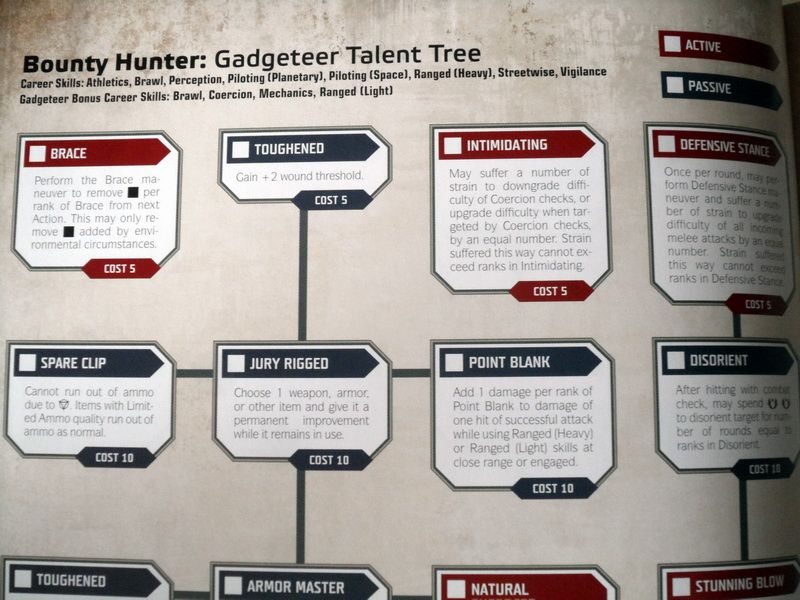
 I mentioned "Force sensitive" characters earlier in this review, and being a force sensitive character isn't a career but a generic specialization which you can invest your XP into in order to unlock additional skills and talent trees. The powers and force abilities available are very low level and mainly allow players to manipulate objects, heighten their senses, add boost dice to their skill checks. You can't pull any proper Jedi/Sith tricks on people, neither is the force in the book divided into a light/dark side path. The idea is simply to be exactly what the name implies - a force sensitive character with minor abilities.
I mentioned "Force sensitive" characters earlier in this review, and being a force sensitive character isn't a career but a generic specialization which you can invest your XP into in order to unlock additional skills and talent trees. The powers and force abilities available are very low level and mainly allow players to manipulate objects, heighten their senses, add boost dice to their skill checks. You can't pull any proper Jedi/Sith tricks on people, neither is the force in the book divided into a light/dark side path. The idea is simply to be exactly what the name implies - a force sensitive character with minor abilities.Players also pick a character motivation, which comes in three categories: Ambition, Cause and Relationship. You can sometimes roll your motivation to include two of the categories. Once you know your motivation category is Ambition, you roll again to see exactly what it is - it may be status, greed, power, freedom etc. This give you an idea of what your character may think, want and need as well as how to role-play him/her properly and let the character rather than your own personal judgment decide upon the choices presented during a session.
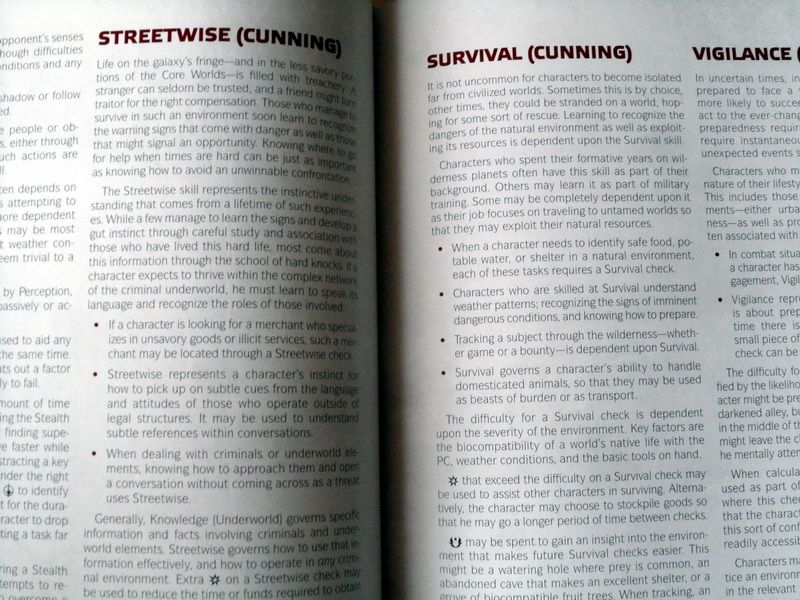
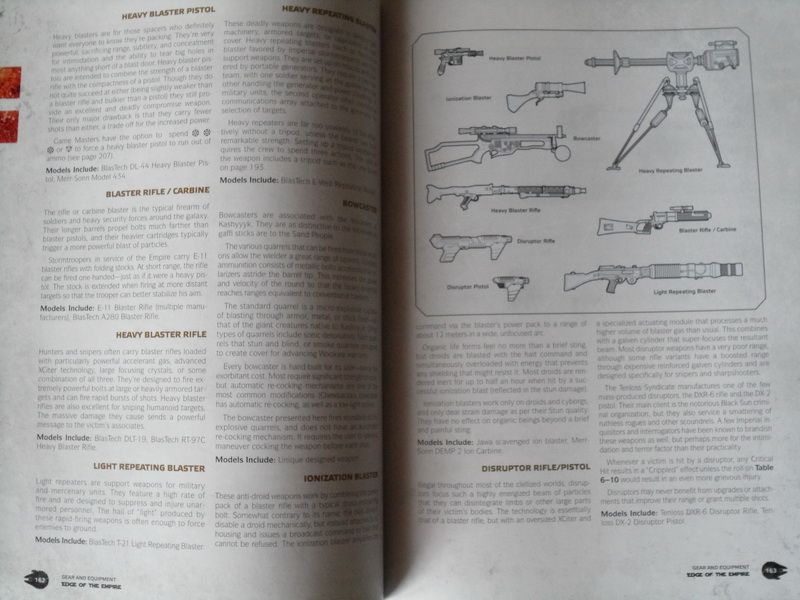 The last thing involved with character creation, and something which I'm really a fan of, is the "obligation". Obligation is something you randomly determine (or hand pick) from a chart, and it can be anything from being wanted, to be in debt to someone. The magnitude of your obligation can increase or decrease during the campaign, but never completely go away. This also means that every character in your party will have an obligation, and each player will have his own personal obligation value. The personal obligation is bound to a certain player - but the combined obligation of the group affects the entire group. At the start of each session, you count the obligation points and roll a D100 to see whether or not the obligation is triggered in the upcoming adventure. If it is, then all character suffer stress from the burden of their
The last thing involved with character creation, and something which I'm really a fan of, is the "obligation". Obligation is something you randomly determine (or hand pick) from a chart, and it can be anything from being wanted, to be in debt to someone. The magnitude of your obligation can increase or decrease during the campaign, but never completely go away. This also means that every character in your party will have an obligation, and each player will have his own personal obligation value. The personal obligation is bound to a certain player - but the combined obligation of the group affects the entire group. At the start of each session, you count the obligation points and roll a D100 to see whether or not the obligation is triggered in the upcoming adventure. If it is, then all character suffer stress from the burden of their 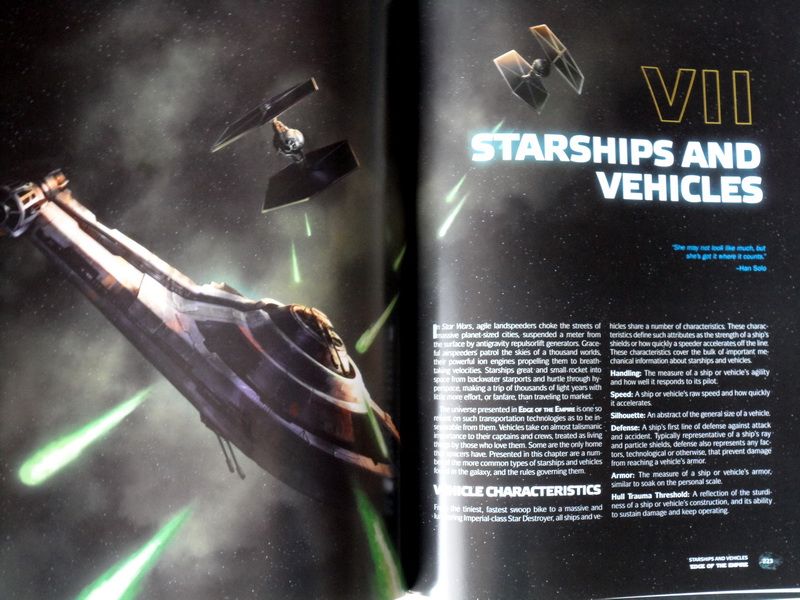 obligations, and the GM can weave in the background of the targeted character into the storyline. Perhaps a bounty hunter shows up demanding you to settle a debt in the middle of your adventure. Whatever it is and however it is done, it adds another layer of events and story into the game and can be a great tool for crafting relevant adventures.
obligations, and the GM can weave in the background of the targeted character into the storyline. Perhaps a bounty hunter shows up demanding you to settle a debt in the middle of your adventure. Whatever it is and however it is done, it adds another layer of events and story into the game and can be a great tool for crafting relevant adventures.The book is very well written , with lots of informative examples and descriptions of situations that may occur. The amount of equipment available is just enough imo to get you started, there isn't a lot of exotic items - but the list of weapons, armor and equipment should be
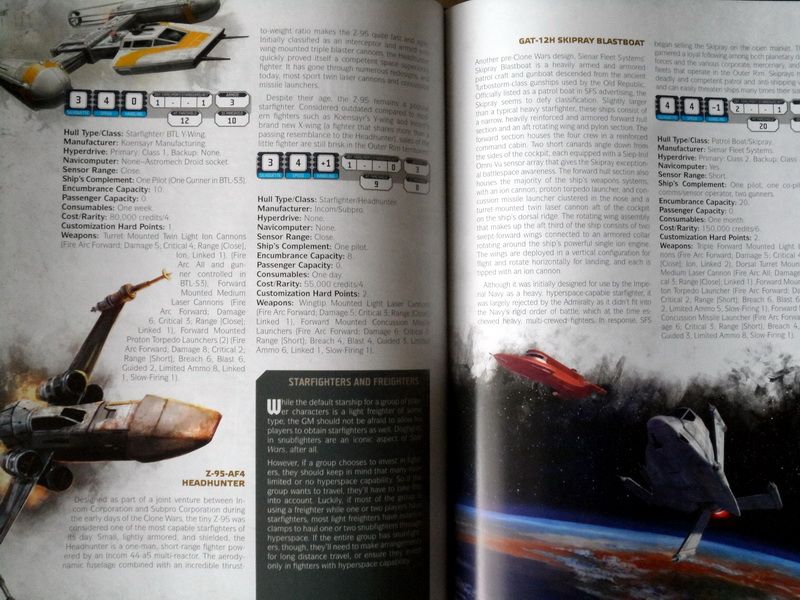 satisfying enough. There is also a list of ships to use as adversaries or player transports, the nice thing is that if you want more ships from outside of the book then you can simply turn to Wookiepedia as all the ships have price information, armament, etc taken straight from that site. Granted that you will need to come up with a couple of things yourself, such as the number modification hardpoints and such but the majority of required information is available through that site.
satisfying enough. There is also a list of ships to use as adversaries or player transports, the nice thing is that if you want more ships from outside of the book then you can simply turn to Wookiepedia as all the ships have price information, armament, etc taken straight from that site. Granted that you will need to come up with a couple of things yourself, such as the number modification hardpoints and such but the majority of required information is available through that site.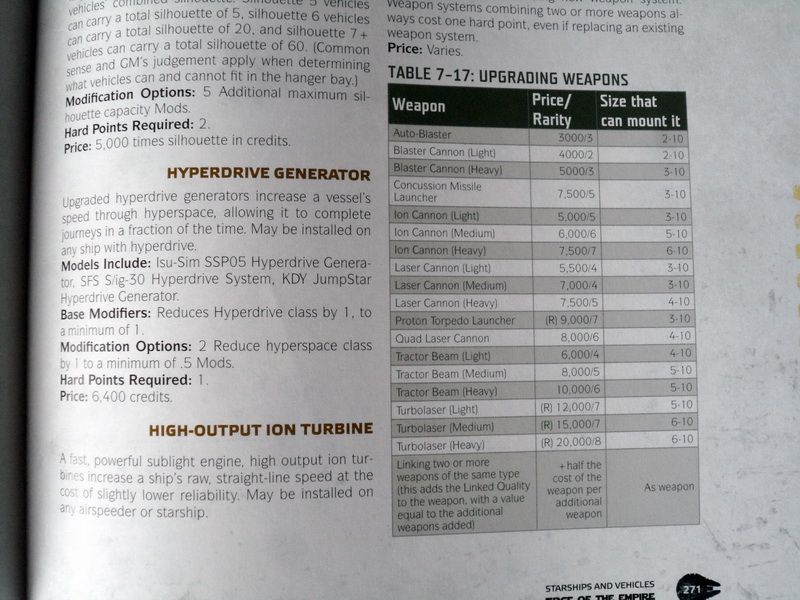 Edge of the Empire also includes a superb map of the Star Wars galaxy, complete with trade routes and all planets, all the regions marked and a complete list of planets region by region to get you started. You also get a rundown of the Imperial bureaucracy and information on the Rebel Alliance and the Black Sun - a confederation of criminal lords. There is also info and background on the Hutts, corporations, pirates, Imperial law , criminal justice, how the sectors are governed and a lot of other background information for the GM to delve into in order to create detailed and accurate campaigns.
Edge of the Empire also includes a superb map of the Star Wars galaxy, complete with trade routes and all planets, all the regions marked and a complete list of planets region by region to get you started. You also get a rundown of the Imperial bureaucracy and information on the Rebel Alliance and the Black Sun - a confederation of criminal lords. There is also info and background on the Hutts, corporations, pirates, Imperial law , criminal justice, how the sectors are governed and a lot of other background information for the GM to delve into in order to create detailed and accurate campaigns. There is also a full chapter on adversaries which is filled with minions, rivals and nemeses characters (the three classes of enemy characters in the game). The listed profiles should be enough to keep players and the GM occupied for a good while, and can of course be used as templates for your own creations.
There is also a full chapter on adversaries which is filled with minions, rivals and nemeses characters (the three classes of enemy characters in the game). The listed profiles should be enough to keep players and the GM occupied for a good while, and can of course be used as templates for your own creations.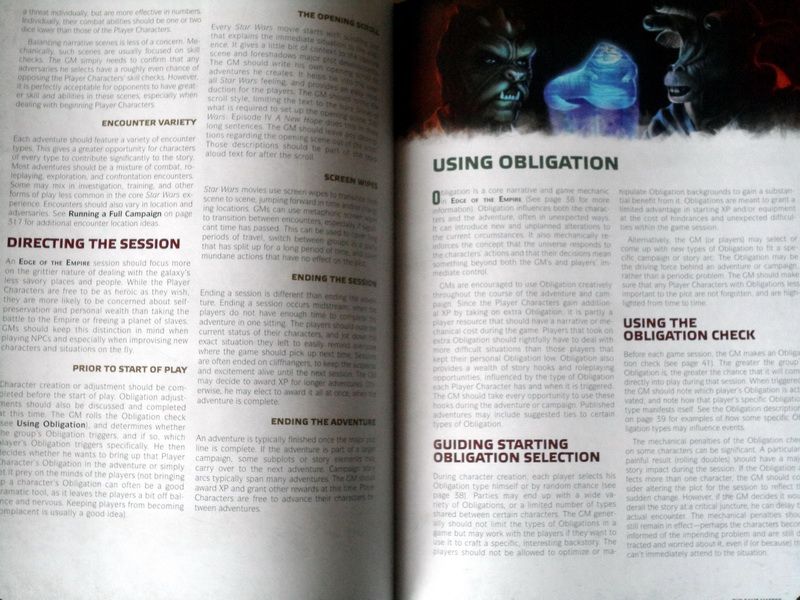 Everything in the book is accompanied by useful tips for the players and the game master, there is even a full chapter dedicated for the GM talking about how to run a campaign and how to avoid certain pitfalls,
Everything in the book is accompanied by useful tips for the players and the game master, there is even a full chapter dedicated for the GM talking about how to run a campaign and how to avoid certain pitfalls, 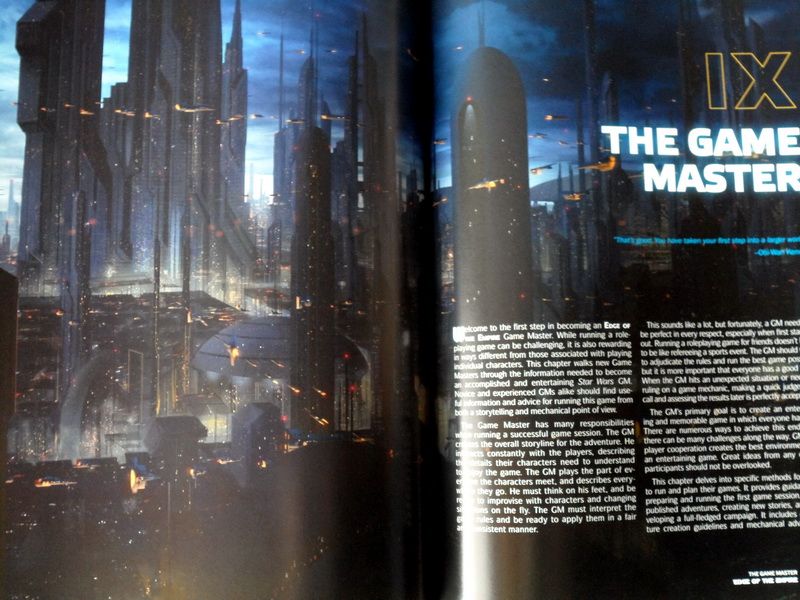 how to use the narrative dice, how to use the character motivations/obligations in your campaigns and so on. Everything is very user friendly and well presented in a well structured manner. For someone like me, who has never played a Pen&Paper RPG before this approach is perfect and allowed to to easily skim the important chapters of the main rulebook to get an idea of the game mechanics and get a bunch of campaign ideas.
how to use the narrative dice, how to use the character motivations/obligations in your campaigns and so on. Everything is very user friendly and well presented in a well structured manner. For someone like me, who has never played a Pen&Paper RPG before this approach is perfect and allowed to to easily skim the important chapters of the main rulebook to get an idea of the game mechanics and get a bunch of campaign ideas.Gameplay elements that stand out
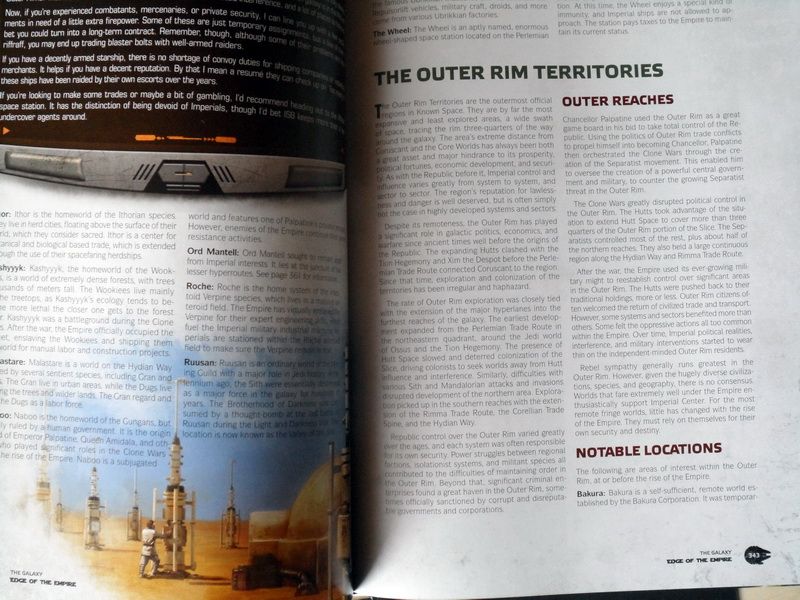 A few things have stood out during our first session of the game, the narrative dice combined with the core mechanics really favor players helping each other out in order to overcome a situation. Be it through use of narrative dice to add positive modifiers to a friendly character who is next in line on the turn initiative, or by directly helping another character with things like medical checks. Two skilled characters can combined their knowledge in order to severely improve their chances to mend wounds or fix a piece of broken machinery. If a skilled character is aided by a helpful but clueless character you still get a bonus die during your skill check for having an assistant.
A few things have stood out during our first session of the game, the narrative dice combined with the core mechanics really favor players helping each other out in order to overcome a situation. Be it through use of narrative dice to add positive modifiers to a friendly character who is next in line on the turn initiative, or by directly helping another character with things like medical checks. Two skilled characters can combined their knowledge in order to severely improve their chances to mend wounds or fix a piece of broken machinery. If a skilled character is aided by a helpful but clueless character you still get a bonus die during your skill check for having an assistant. Space combat is something me and my buddy Thomas have only experimented with, but the way ships and the game is written, every player in your party should have something to do. There is a pilot slot, a co-pilot slot, engineer and gunner slots. Player assign their characters to these, and can run between stations during combat if they are on a larger vessel. This creates something resembling the combat scenes with the Millennium Falcon, several characters manning different stations pulling their own weight and adding something to the situation. There is also a LOT to do for everyone aboard a ship, the pilot has multiple maneuvering options that affect the gunner and the enemy ships. Someone with great leadership can order people on the ship to perform better, engineers can help alter the shields deflectors and do repairs, even a brutish character can help out by doing manual repairs with his physical strength.
Space combat is something me and my buddy Thomas have only experimented with, but the way ships and the game is written, every player in your party should have something to do. There is a pilot slot, a co-pilot slot, engineer and gunner slots. Player assign their characters to these, and can run between stations during combat if they are on a larger vessel. This creates something resembling the combat scenes with the Millennium Falcon, several characters manning different stations pulling their own weight and adding something to the situation. There is also a LOT to do for everyone aboard a ship, the pilot has multiple maneuvering options that affect the gunner and the enemy ships. Someone with great leadership can order people on the ship to perform better, engineers can help alter the shields deflectors and do repairs, even a brutish character can help out by doing manual repairs with his physical strength.  Character interaction is also great as you make opposed rolls. If you negotiate over the price with an NPC you make a negotiation skill check vs the opponents skill check. The same goes for threats, coercion, lies and charming stories meant to distract attention. This also allows for tailoring NPC's to fit the current level of player characters or to provide a good enough challenge. It also makes characters flex their own skills against the skills of someone else in a more interactive manner than to simply roll on your own skill to succeed.
Character interaction is also great as you make opposed rolls. If you negotiate over the price with an NPC you make a negotiation skill check vs the opponents skill check. The same goes for threats, coercion, lies and charming stories meant to distract attention. This also allows for tailoring NPC's to fit the current level of player characters or to provide a good enough challenge. It also makes characters flex their own skills against the skills of someone else in a more interactive manner than to simply roll on your own skill to succeed. There are no levels in the game, only experience points. Character growth is also more natural with slight increase of XP during each session - there won't be any huge jumps of stat increases. You also don't get XP for kills or completing "quests". All XP rewarded are based upon XP guidelines in the book and upon the GM himself. It is also harder to "powergame" the system the way characters are created and characteristics and skills interact with each other - and character creation has a cap on how far skills and characteristics can be improved from the start.
There are no levels in the game, only experience points. Character growth is also more natural with slight increase of XP during each session - there won't be any huge jumps of stat increases. You also don't get XP for kills or completing "quests". All XP rewarded are based upon XP guidelines in the book and upon the GM himself. It is also harder to "powergame" the system the way characters are created and characteristics and skills interact with each other - and character creation has a cap on how far skills and characteristics can be improved from the start.
Destiny points, at the start of each session each player rolls the neutral "Force die". This die has black and white dots covering it, and the results of all players are combined into a shared pool of light and dark destiny points. Light side are used the player characters, dark side are used by the GM. The thing is that this pool is constant, but whenever the GM spends a dark side point it turns into a light side and is added to the player character pool. This creates an ebb and flow of destiny points, which are used to bolster your or the GM's skill check's.
Using a destiny point upgrades an ability die (green) to a proficiency die (yellow) - or from a difficulty die (purple) to a challenge die (red). The points are also used by force sensitive characters who want to use their force skills and abilities. This added twist to the game is great, and the system allows for players to boost a crappy dice pool during a crucial check or allow the GM to increase the difficulty to better suit the situation or story if he thinks the players are having it too easy.
Conclusion
All in all Star Wars: Edge of the Empire is a great ruleset and has fantastic potential for telling interesting stories - using the setting and combining it with the narrative dice. It does require you to accept the dice mechanics, and if you can't overcome this threshold you may not like the game. But in that case I think you are really missing out on a great set of rules. The way everything is described and the possibilities are both detailed and seemingly endless. Also, players looking to play a real Jedi/Sith character will have to wait for the later core rulebook releases in the years to come - but those who want to play "regular" characters should have a great time using this book.
The guys and me are only starting out a campaign, but so far everyone likes the rules and mechanics. As the GM I have read up on more stuff than was covered in the Beginner Game boxed set adventure and know about more rules than the players have encountered so far. As such I am greatly enthusiastic and look forward to crafting my own campaign and adventures for the group.
This is a game that I would highly recommend to any Star Wars and RPG fan.

No comments:
Post a Comment